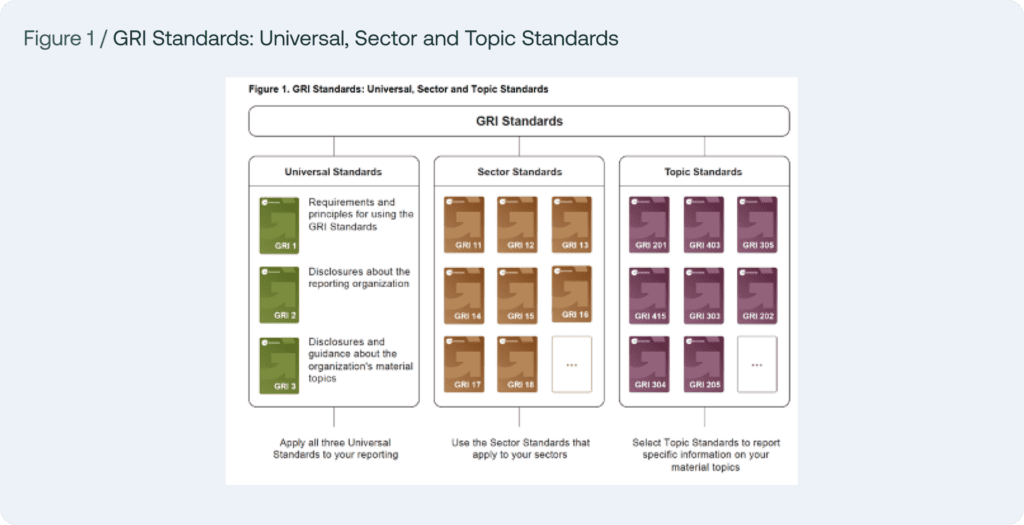 Redefining business success: The case for B Corp certification
Redefining business success: The case for B Corp certification
“Sustainability reporting is a process that starts with an organisation determining its material topics based on its most significant impacts on the economy, the environment, and people, including its impacts on people’s human rights.”
GRI: The world’s sustainability standard
Establishing a reliable framework for sustainability reporting is essential for driving progress on the issues that matter most – from carbon emissions to biodiversity.
Set up over 25 years ago, Global Reporting Initiative (GRI) has developed the most widely used sustainability reporting standard, adopted by more than 14,000 organisations around the world.
But with a range of sector- and topic-specific standards, it’s important to clarify how to incorporate the GRI Standards into your reporting strategy. This blog provides a detailed overview of what to expect from the GRI reporting process, and how your company can prepare for successful compliance.
Get to know the GRI Standards
The GRI Standards are a harmonised set of reporting principles designed to help organisations report transparently to stakeholders on their sustainability performance.
The Standards include a set of ‘disclosures’, providing a framework for companies to share information about themselves and their impacts on the environment, the economy and people. These disclosures come with specific requirements and recommendations to ensure the consistency and comparability of reporting across industries.
The Standards in detail
Covering a wide range of environmental, economic and social topics, the GRI Standards are renowned for their comprehensiveness. And in 2021, GRI released its new reporting standards. These new standards will apply to all organisations publishing reports in reference to or in accordance with the GRI Standards after 1 January 2023.
Several sector-specific standards have also been published since, including GRI 13: Agriculture, Aquaculture and Fishing Sectors 2022. Below, we break down the differences between the standards and explain how to determine which ones apply to your organisation.

Universal Standards
GRI 1: Foundation 2021
GRI 1: Foundation 2021 explains the ‘why’ and ‘how’ of reporting against the GRI Standards. It highlights their purpose and the key principles to follow when reporting. It also explains the following key concepts.
- Impact: the effect that the organisation’s activities have or could have on the environment and society.
- Material topics: the impacts of organisation, prioritised according to their importance to the organisation and its stakeholders.
- Due diligence: the processes followed by the organisation to identify, prevent and mitigate its negative impacts.
- Stakeholders: all third parties affected by the organisation’s activities.
Reporting principles
GRI 1: Foundation 2021 also includes a set of principles to guide the reporting process, ensuring your organisation’s sustainability performance is represented fairly and accurately. These principles are listed below.
- Accuracy: the information is correct and sufficiently detailed.
- Balance: the information is presented in an unbiased manner and provides a fair representation of negative and positive impacts.
- Clarity: the information is accessible and understandable.
- Comparability: the information is selected, compiled and reported in a consistent manner.
- Completeness: the level of information disclosed is sufficient to assess an organisation’s impacts.
- Sustainability context: information on the organisation’s impacts is contextualised within the wider sustainable development landscape.
- Timeliness: information is disclosed regularly and in time for decision-making purposes.
- Verifiability: the quality of the information disclosed can be independently verified.
Adhering to these principles is essential to ensure that reporting is of the highest quality and reflects an organisation’s current sustainability progress.
GRI 2: General Disclosures 2021
The standard GRI 2: General Disclosures aims to present the profile of the reporting entity by looking at: the organisation and its reporting practices, its activities and people, its governance structures, its strategy, policies and practices, and its stakeholder engagement approach.
GRI 3: Material Topics 2021
This section provides guidance on how an organisation should determine, disclose and manage its material topics. The process starts with a materiality analysis, through which an organisation can identify the most significant environmental and social impacts it generates. To conduct a materiality analysis, you need to:
- Understand your organisation’s context;
- Identify your actual and potential impacts;
- Assess the significance of your impacts;
- Prioritise the most significant impacts for reporting.

According to GRI 3: Material Topics 2021, the disclosure framework should include:
Disclosure 3-1: Process to define material topics
The reporting organisation must disclose the process used to identify and prioritise material topics.
Disclosure 3-2: List of material topics
The organisation must disclose the list of all material topics identified through the materiality analysis. The results may also be presented in a sustainability materiality matrix, to be referenced in the content index.
Disclosure 3-3: Management of material topics
The organisation must describe the actual and potential, both negative and positive, that it generates. For each material topic, the reporting entity must disclose the actions taken to manage the topic and its related impacts.
Sector Standards
Through its Sector Programme, the GRI is in the process of developing specific Sector Standards for 40 industries, starting with those that generate the largest environmental impacts. These standards support organisations in their sustainability reporting by defining material topics for their industry, as well as key information they need to disclose.
The Sector Standards are currently available for the following sectors:
- GRI 11: Oil and Gas Sector 2021
- GRI 12: Coal Sector 2022
- GRI 13: Agriculture, Aquaculture and Fishing Sectors 2022
- GRI 14: Mining Sector 2024 (applicable from 1 January 2026)
If your organisation operates in one of the sectors listed above, you should use the Sector Standards when preparing your sustainability report.
These can be found in the GRI Resource Centre. In addition, new Sector Standards are currently being developed for a range of industries, including textiles and apparel, and financial services. Developing specific standards for more sectors will enable even more relevant and representative impact reporting.
If a specific Sector Standard is not yet available for your industry, you should select the topical standards relevant to your organisation.
Topical Standards
The GRI topical standards are applied based on the material topics identified through the materiality analysis. Each standard provides an overview of exactly what the reporting entity should disclose on that topic. Therefore, organisations should select the topical standards that correspond to their material topics and use them to guide their reporting.
Below are some examples of topical standards:
- GRI 204: Procurement Practices 2016
- GRI 205: Anti-corruption 2016
- GRI 302: Energy 2016
- GRI 303: Water and Effluents 2018
- GRI 304: Biodiversity 2016
- GRI 306: Waste 2020
- GRI 403: Occupational Health and Safety 2018
- GRI 404: Training and Education 2016
- GRI 405: Diversity and Equal Opportunity 2016
- GRI 410: Security Practices 2016
- GRI 416: Customer Health and Safety 2016
The Topic Standards are also available in the GRI’s Resource Centre.
Why are the GRI Standards important?
Disclosing your sustainability efforts in line with the GRI Standards is about much more than showcasing your performance on environmental and social topics to stakeholders. Indeed, the transparency, comprehensiveness and specificity of the standards make them a valuable tool to guide and provide clarity on your sustainability strategy – enabling more consistent performance measurement and improved risk management.
Producing a GRI-compliant report can also provide reputational benefits, both in terms of improving employee engagement and facilitating collaboration with customers and other value chain partners. In addition, more than 40 stock exchanges around the world require companies to use the GRI Standards for sustainability reporting.
The GRI Standards are also closely aligned with other international sustainability standards, such as the ISSB disclosure standards. GRI reporting can therefore help you meet a range of regulatory and stakeholder requirements – potentially paving the way for B Corp certification or a higher EcoVadis rating. It’s also a valuable tool for measuring your organisation’s performance over time and benchmarking against competitors.
Who are the GRI Standards for and how are they used?
Among the most common questions asked by clients who want to start applying the GRI Standards in their reporting are ‘Who can report?’ and ‘When should I start?’. The first question is simple to answer. GRI reporting is an option for any organisation, regardless of size, type, country of operation or reporting experience. The answer to the question of ‘when’ is more complex.
The GRI Standards are voluntary, so there’s no legal requirement to report in line with them. However, shareholders and other value chain partners may request it as evidence of your progress on sustainability matters. In addition, GRI compliance can be a useful stepping stone towards compliance with legally binding reporting standards, such as the CSRD, as well as IFRS-aligned standards.

There are therefore many benefits to kicking off the process as soon as you can. And the best starting point is understanding and identifying what specific disclosure requirements apply to your company. This is essential to facilitate the data-gathering process, as well as the materiality assessment and stakeholder engagement. These steps are often time-consuming and need to be conducted regularly to ensure your reporting remains up to date.
Reporting “in accordance” with vs “in reference” to
Before the introduction of the new standards, organisations could choose to prepare a GRI Sustainability Report in accordance with the Standards under either the Core or Comprehensive option.
However, under the new GRI Standards 2021, the only two options available are to report ‘in accordance with’ the standards and ‘in reference to’ the standards.
Reporting ‘in accordance with’ the GRI Standards
This is the most rigorous option, requiring compliance with all nine requirements highlighted in the Standards. Companies that want to report ‘in accordance with’ the GRI Standards 2021 will need to:
- apply all of the reporting principles outlined in GRI 1;
- report on GRI 2: General Disclosures;
- identify material topics;
- report on GRI 3: Material Topics;
- report on each material topic;
- provide reason(s) for omission where compliance with specific disclosures and/or requirements is not possible;
- publish a GRI content index;
- provide a statement of use;
- notify GRI.
Reporting ‘in reference to’ to the GRI Standards
For companies starting on their GRI journey, reporting ‘in reference to’ the GRI Standards can be a first step towards full compliance, providing a more accessible pathway. It has fewer requirements than reporting ‘in accordance with’ the GRI Standards, requiring organisations to:
- comply with only three of the nine requirements (publish a GRI content index, provide a statement of use and notify GRI);
- apply the reporting principles outlined above;
- explain how material topics are managed (using GRI 3).
Frequently Asked Questions
Is there a way to reference the GRI Standards or use them as guidance without publishing a fully GRI-compliant report?
Yes, you can report ‘with reference to’ the GRI Standards (as opposed to ‘in accordance with’ the Standards). While you must still follow the eight reporting principles, you do not need to adhere to all nine reporting requirements. Instead, you only need to (1) publish a GRI content index (2) provide a statement of use and (3) Notify GRI.
Is it mandatory to have the report certified by GRI in order to publish it with the GRI logo?
You don’t need to have your report certified by GRI to publish it with the GRI logo. However, you must comply with the nine reporting requirements and the eight reporting principles. Once you have produced a sustainability report in accordance with the GRI standards, you need to notify the GRI.
Do the GRI and SASB standards have the same requirements for conducting a materiality analysis?
With respect to the materiality analysis, both standards require such an analysis to be conducted. There are guidelines and suggestions on how to carry it out, but these steps themselves aren’t mandatory. The only requirement is that the analysis is completed and the process described.
Where can I find the GRI Standards 2021?
All resources can be found on the GRI website by following this link.
Have the GRI Standards 2021 already taken effect?
Yes. For organisations choosing to apply the GRI Standards, the 2021 Standards have been in effect for reporting from 1 January 2023.
Is it possible to omit certain disclosures or requirements?
If your organisation cannot comply with a specific disclosure or requirement, you must provide a valid reason for the omission. In particular, the organisation should highlight missing information in the content index and provide one of the following four reasons for omission:
- not applicable;
- legal prohibitions (to be described);
- confidentiality constraints;
- unavailable or incomplete information.
How do I notify GRI about my report?
To notify GRI, you can use the GRI Standards Report Registration System. Your submission may take some time to process, but this will not affect your compliance with the notification requirement.











